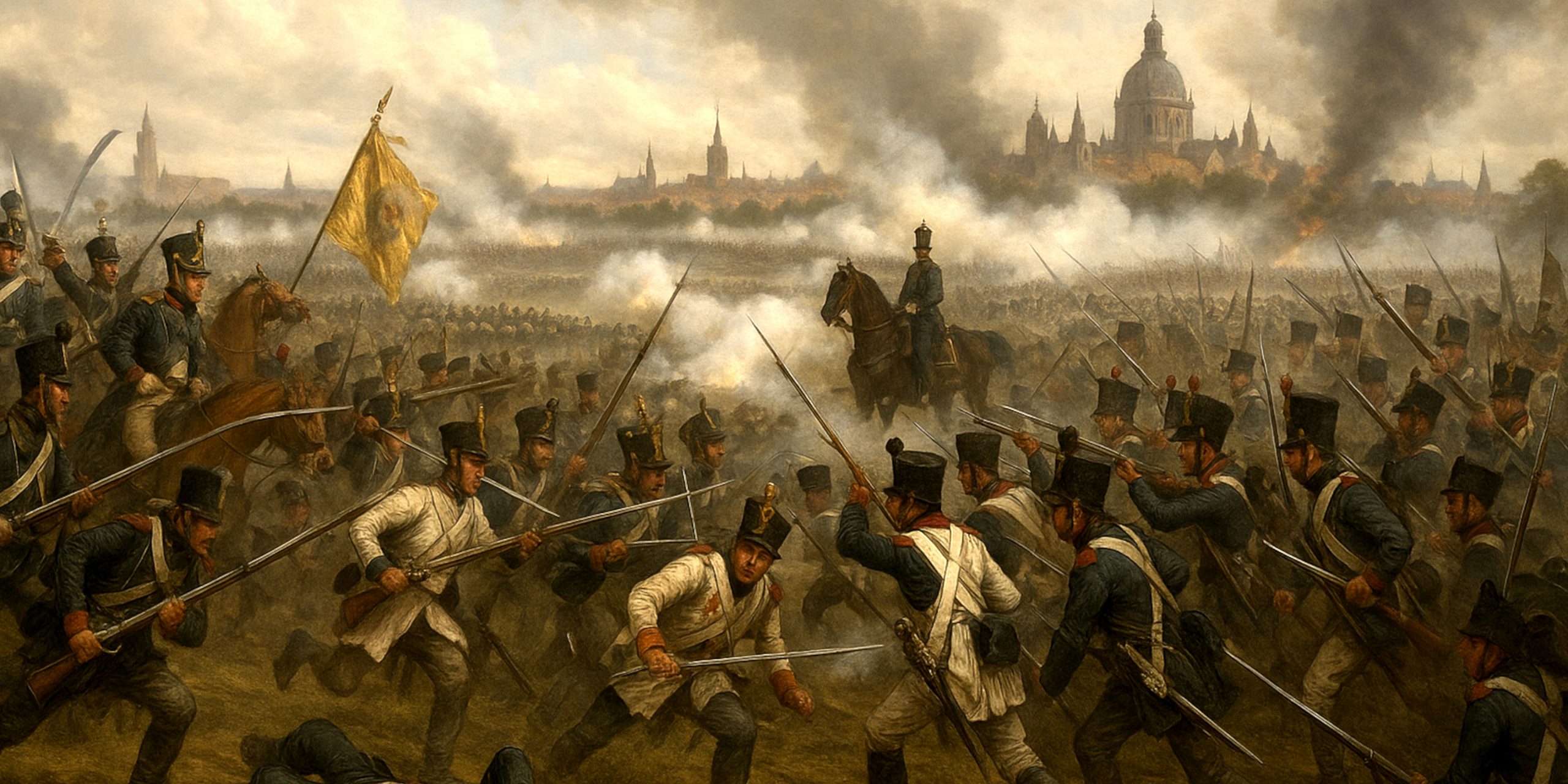
The Battle of Leipzig, also known as the Battle of the Nations, was the largest military confrontation in Europe prior to the First World War. Fought from 16 to 19 October 1813, it marked a decisive turning point in the Napoleonic Wars, as Napoleon Bonaparte faced a vast coalition determined to end his control of central Europe. The engagement resulted in a catastrophic defeat for the French and signalled the collapse of the Napoleonic presence east of the Rhine.
Background
By 1813, the tide had turned against Napoleon. His failed invasion of Russia the previous year had decimated the Grande Armée. In response, the Sixth Coalition was formed, comprising Austria, Prussia, Russia, Sweden, and others. Napoleon attempted to reassert control in central Germany but was outnumbered and increasingly isolated diplomatically and militarily.
Leipzig was chosen not by strategic design but because French forces were cornered near the city, with multiple allied armies converging from different directions.
Forces
Coalition Forces
| Nation | Estimated Troops | Commanders |
|---|---|---|
| Russia | 130,000 | Tsar Alexander I, Prince Schwarzenberg (overall) |
| Austria | 110,000 | Karl von Schwarzenberg, Prince of Hesse-Homburg |
| Prussia | 72,000 | Gebhard Leberecht von Blücher |
| Sweden | 30,000 | Crown Prince Charles John (Bernadotte) |
| Saxon defectors | 5,000 | Switched sides during the battle |
| Total | ~345,000 |
French Forces
| Unit Type | Estimated Numbers | Commanders |
|---|---|---|
| Infantry and Artillery | ~190,000 | Napoleon Bonaparte, Marshals Ney, MacDonald, Marmont |
| Cavalry | ~30,000 | Murat (King of Naples), Latour-Maubourg |
| Allies (Saxons, Poles, Italians) | ~15,000 | Prince Poniatowski, General Reynier |
| Total | ~235,000 |
Arms and Armour
French Forces
- Standard armament included Charleville muskets, sabres, and light artillery such as 6- and 12-pounder cannons.
- Heavy cavalry (Cuirassiers) were equipped with breastplates and helmets.
- Officers and elite units bore ornate swords and pistols, while Imperial Guard units retained better-quality equipment than the rest.
Coalition Forces
- Russian troops largely used the 1805 musket and shashkas; artillery was strong in quantity though outdated in design.
- Austrian forces brought disciplined infantry and reliable heavy artillery.
- Prussian soldiers carried the Potsdam musket, and many wore shakos and cartridge boxes from previous campaigns.
- Swedish units were relatively lightly engaged but well-equipped with British-supplied muskets.
Archaeology
Modern excavations around Leipzig have uncovered thousands of musket balls, uniform buttons, bayonets, and mass graves. A major find in 2013 revealed the remains of French and Polish soldiers near Möckern, consistent with eyewitness accounts of the brutal close-quarters fighting.
The Monument to the Battle of the Nations (Völkerschlachtdenkmal), built in 1913, remains a focal point. Beneath it lie crypts with the remains of both French and Coalition soldiers. Ground-penetrating radar surveys continue to map former fieldworks and encampments in surrounding farmland.
Battle Timeline

16 October 1813
- Main fighting erupted near Wachau and Möckern.
- French held ground in the south, while Prussians advanced from the north.
- Marshal Ney’s delay in supporting the north weakened Napoleon’s position.
17 October 1813
- A lull in fighting as both sides reorganised.
- Coalition forces continued to bring in reserves, further outnumbering the French.
18 October 1813
- Largest day of battle, with over 200,000 men engaged.
- Saxon troops in Napoleon’s army defected mid-battle.
- French were gradually pushed back towards Leipzig.
19 October 1813
- Napoleon ordered retreat westward.
- A key bridge over the Elster River was blown too early, trapping thousands of French troops.
- Prince Józef Poniatowski drowned attempting to escape.
Contemporary Quotes
Prince Metternich (Austrian diplomat):
“This struggle has shown that no nation, however great its genius, can long triumph over the combined will of others.”
Marshal MacDonald (French commander):
“We are not beaten by men, but by fate and by the treachery of time.”
Napoleon Bonaparte:
“What a disaster. I have lost everything except honour.”
Legacy
The defeat at Leipzig shattered Napoleon’s grip on Germany. He retreated across the Rhine and would never again control such a vast swathe of Europe. The coalition pressed on, eventually forcing Napoleon’s abdication in April 1814.
Leipzig also marked the beginning of the end for the Napoleonic system of satellite states. It affirmed the emergence of nationalist resistance to foreign rule and helped lay the groundwork for the eventual unification movements in Germany and Italy.
Today, the battle is remembered not only for its immense scale but for its symbolic role in ending an era of French dominance on the continent. The ground remains hallowed in military history, a site where over half a million men clashed in the name of empire and resistance.
Watch the documentary:



